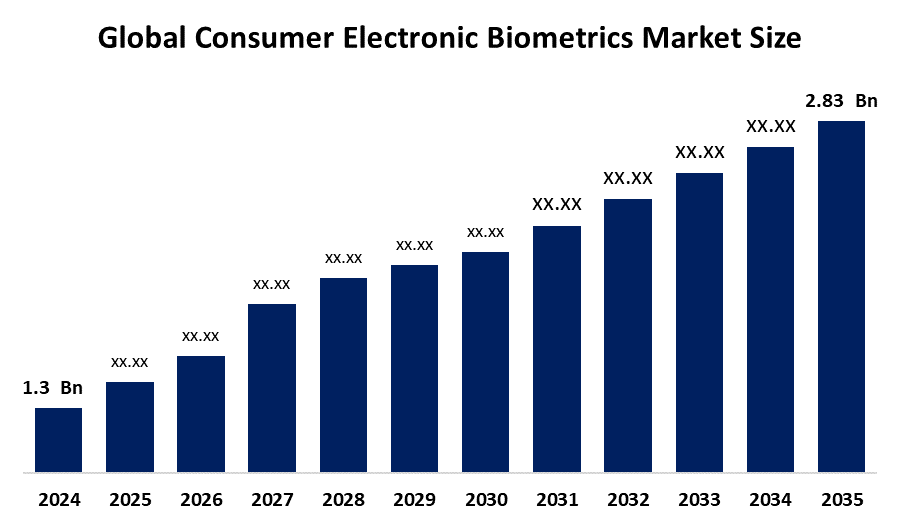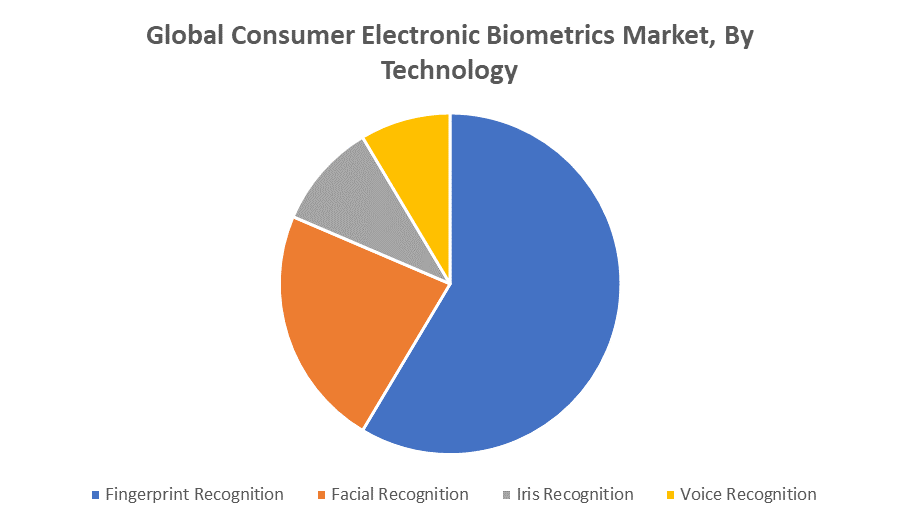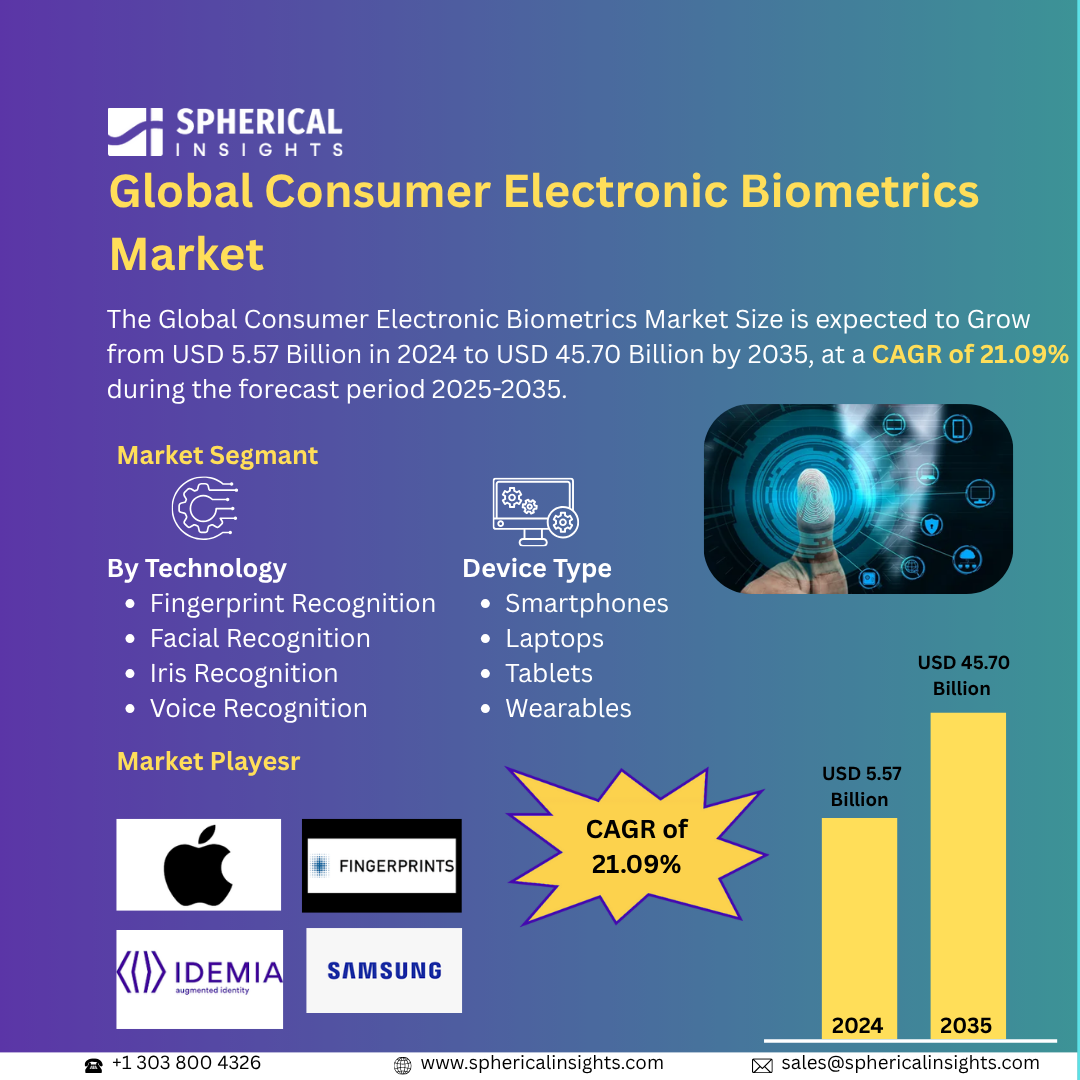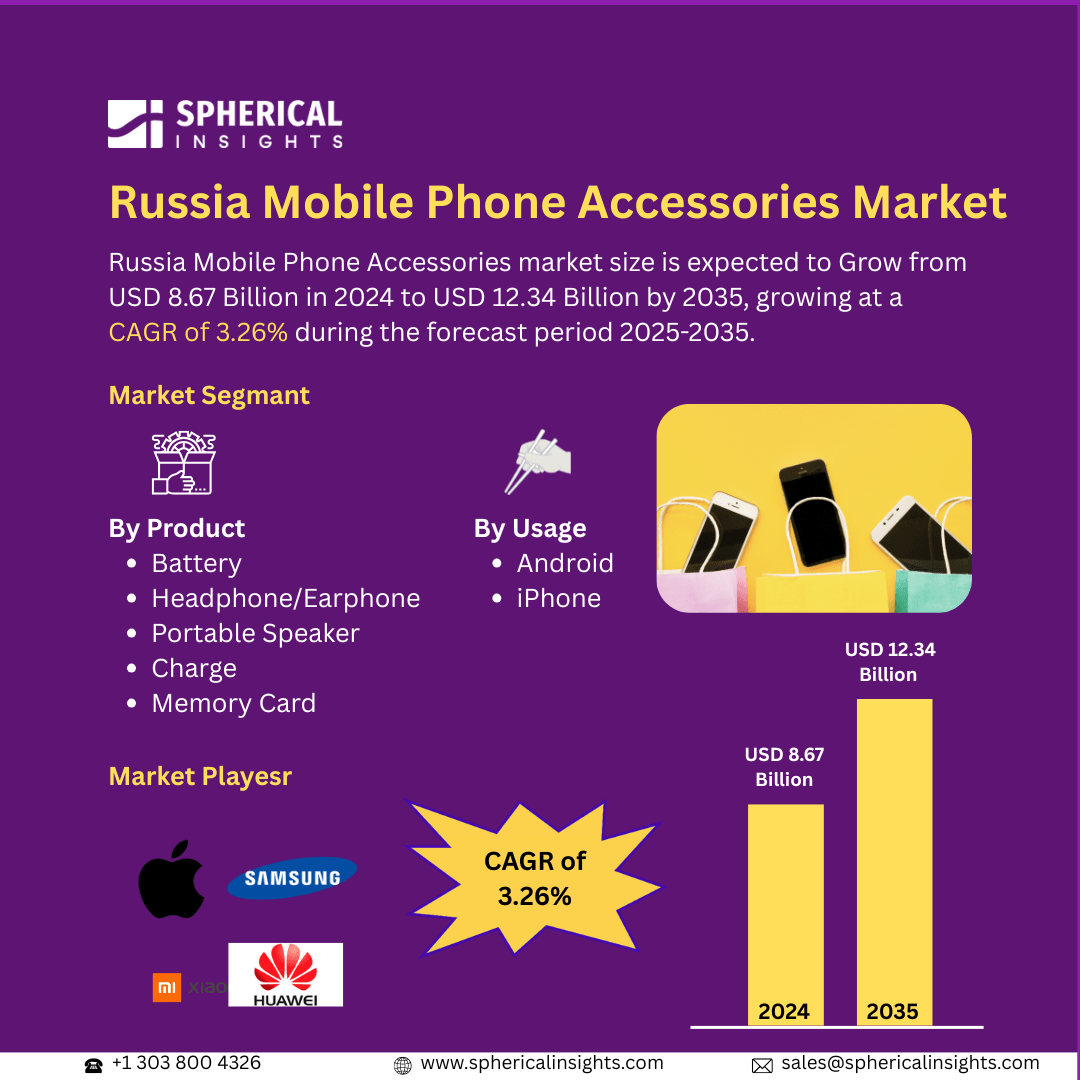Global Consumer Electronic Biometrics Market Insights Forecasts to 2035
- The Global Consumer Electronic Biometrics Market Size Was Estimated at USD 5.57 Billion in 2024
- The Market Size is Expected to Grow at a CAGR of around 21.09% from 2025 to 2035
- The Worldwide Consumer Electronic Biometrics Market Size is Expected to Reach USD 45.70 Billion by 2035
- Asia Pacific is expected to grow the fastest during the forecast period.

Consumer Electronic Biometrics Market
The global consumer electronic biometrics market refers to the industry focused on biometric technologies integrated into consumer electronics, such as smartphones, laptops, wearables, and smart home devices. These technologies include fingerprint recognition, facial recognition, iris scanning, and voice recognition, enhancing security and user convenience. Government initiatives worldwide are actively promoting biometric adoption to improve cybersecurity, identity verification, and digital privacy, with regulations encouraging biometric integration in consumer products. Increasing demand for secure authentication methods, growing smartphone penetration, and advancements in AI and sensor technologies drive market growth. The market is also influenced by rising concerns over data security and fraud prevention. Key players are investing in innovation to develop faster, more accurate, and user-friendly biometric solutions. Overall, the consumer electronic biometrics market is expected to expand rapidly, fueled by technological advancements, regulatory support, and increasing consumer preference for seamless, secure device access.
Attractive Opportunities in the Consumer Electronic Biometrics Market
- With the rise of hygiene concerns post-pandemic, consumers and industries are increasingly seeking touchless, seamless authentication solutions. This trend opens up opportunities for biometric technologies to integrate more deeply into healthcare, banking, retail, and smart home devices.
- Combining biometrics with AI, Internet of Things (IoT), and cloud platforms can create more advanced, secure, and user-friendly authentication systems. This offers new product development avenues and market expansion, especially for connected devices and smart ecosystems.
- Rapid smartphone adoption in countries like China, India, and others, along with government initiatives promoting cybersecurity and biometric use, presents a huge untapped consumer base. This creates significant growth potential for biometric solutions tailored to these emerging markets.
Global Consumer Electronic Biometrics Market Dynamics
DRIVER: Rising need for enhanced security in consumer devices like smartphones
The rising need for enhanced security in consumer devices like smartphones, laptops, and wearables is a primary driver, as biometrics offer more reliable authentication than traditional passwords. Second, increasing smartphone and smart device penetration worldwide is expanding the user base for biometric technologies. Third, advancements in artificial intelligence (AI), machine learning, and sensor technology have significantly improved the accuracy, speed, and convenience of biometric systems. Fourth, growing consumer awareness and preference for seamless and secure access methods are boosting demand. Additionally, government regulations and initiatives promoting biometric authentication for data security and identity verification are accelerating market adoption. Lastly, the surge in digital transactions and remote work post-pandemic has heightened the need for secure user verification, further propelling market growth. Collectively, these factors contribute to the rapid expansion and innovation within the consumer electronic biometrics industry.
RESTRAINT: Privacy concerns and data security risks related to the collection and storage
Privacy concerns and data security risks related to the collection and storage of biometric data can deter consumer adoption. High implementation and maintenance costs of advanced biometric systems limit accessibility, especially in developing regions. Technical challenges such as false positives, environmental interference, and sensor malfunctions affect reliability. Additionally, lack of standardized regulations and interoperability issues across devices create market fragmentation. Resistance from users wary of biometric surveillance and identity theft also slows growth. These factors collectively pose challenges to the widespread adoption and scalability of biometric technologies in consumer electronics.
OPPORTUNITY: Growing demand for contactless and frictionless authentication methods
Increasing integration of biometrics with emerging technologies like artificial intelligence, IoT, and cloud computing offers potential for more advanced, seamless, and secure authentication solutions. The expanding smart home and wearable device markets provide new application areas for biometric technologies. Growing demand for contactless and frictionless authentication methods, especially post-pandemic, creates opportunities for biometric adoption in healthcare, banking, and retail sectors. Additionally, expanding smartphone penetration in developing countries opens new consumer bases. Governments worldwide are also encouraging biometric usage through supportive policies, driving market expansion. Collaborations between technology providers and device manufacturers can further accelerate innovation and market reach, making this an exciting time for investment and development in consumer electronic biometrics.
CHALLENGES: Technical limitations such as inaccuracies
Technical limitations such as inaccuracies, environmental interference, and sensor malfunctions reduce system reliability. High costs of implementation and maintenance restrict adoption, especially in emerging markets. Lack of standardized regulations and interoperability among devices creates market fragmentation. Additionally, ethical concerns around biometric surveillance and potential misuse of data present social and legal challenges, slowing widespread acceptance and integration in consumer electronics.
Global Consumer Electronic Biometrics Market Ecosystem Analysis
The global consumer electronic biometrics market ecosystem includes technology providers, device manufacturers, software developers, regulatory bodies, and end users. Key biometric technologies like fingerprint, facial, iris, and voice recognition drive adoption in smartphones, wearables, and smart homes. North America leads the market, with rapid growth in Asia-Pacific fueled by smartphone penetration. Strict regulations like GDPR ensure data privacy and ethical use. Continuous technological advancements and increasing demand for secure, convenient authentication are fueling significant market growth and innovation worldwide.
Based on the technology, the fingerprint recognition segment accounted for the largest revenue share over the forecast period

The fingerprint recognition segment accounted for the largest revenue share over the forecast period. This dominance is due to its widespread adoption in consumer electronics like smartphones and laptops, offering a cost-effective, reliable, and fast authentication method. Advances in sensor technology and integration into various devices have further strengthened its market position. Additionally, fingerprint recognition’s user-friendly nature and strong security features continue to drive demand, making it the leading biometric technology in the consumer electronics market.
Based on the device type, the smartphones segment accounted for the highest revenue share during the forecast period
The smartphones segment accounted for the highest revenue share during the forecast period. This is driven by the widespread use of biometric authentication, especially fingerprint and facial recognition, in smartphones for secure and convenient user access. The growing global smartphone penetration, continuous innovation in biometric sensors, and consumer demand for enhanced security contribute to this segment’s dominance. Smartphones remain the primary platform for biometric technology adoption, making them the largest revenue generator in the consumer electronic biometrics market.
North America is anticipated to hold the largest market share of the consumer electronic biometrics market during the forecast period
North America is anticipated to hold the largest market share in the consumer electronic biometrics market during the forecast period. This leadership is driven by high adoption rates of advanced biometric technologies in smartphones, laptops, and smart home devices. Strong presence of key technology providers, significant investments in R&D, and supportive government initiatives promoting digital security further boost the region’s market dominance. Additionally, growing consumer awareness and stringent data privacy regulations contribute to the widespread integration of biometric solutions across North America.
Asia Pacific is expected to grow at the fastest CAGR in the consumer electronic biometrics market during the forecast period
Asia Pacific is expected to grow at the fastest CAGR in the consumer electronic biometrics market during the forecast period. Rapid smartphone penetration, increasing disposable incomes, and rising demand for secure authentication in countries like China, India, and Japan drive this growth. Additionally, expanding digital infrastructure, growing smart device adoption, and supportive government initiatives to enhance cybersecurity contribute to the region’s accelerating market expansion. The combination of a large consumer base and technological advancements makes Asia Pacific the fastest-growing market for consumer electronic biometrics.
Key Market Players
KEY PLAYERS IN THE CONSUMER ELECTRONIC BIOMETRICS MARKET INCLUDE
- Apple Inc.
- Samsung Electronics
- IDEMIA
- Fingerprint Cards AB
- Synaptics Incorporated
- Google LLC
- NEC Corporation
- HID Global
- Suprema Inc.
- Goodix Technology
- Others
Market Segment
This study forecasts revenue at global, regional, and country levels from 2020 to 2035. Spherical Insights has segmented the consumer electronic biometrics market based on the below-mentioned segments:
Global Consumer Electronic Biometrics Market, By Technology
- Fingerprint Recognition
- Facial Recognition
- Iris Recognition
- Voice Recognition
Global Consumer Electronic Biometrics Market, By Device Type
- Smartphones
- Laptops
- Tablets
- Wearables
Global Consumer Electronic Biometrics Market, By Regional Analysis
- North America
- Europe
- Germany
- UK
- France
- Italy
- Spain
- Russia
- Rest of Europe
- Asia Pacific
- China
- Japan
- India
- South Korea
- Australia
- Rest of Asia Pacific
- South America
- Brazil
- Argentina
- Rest of South America
- Middle East & Africa
- UAE
- Saudi Arabia
- Qatar
- South Africa
- Rest of the Middle East & Africa





